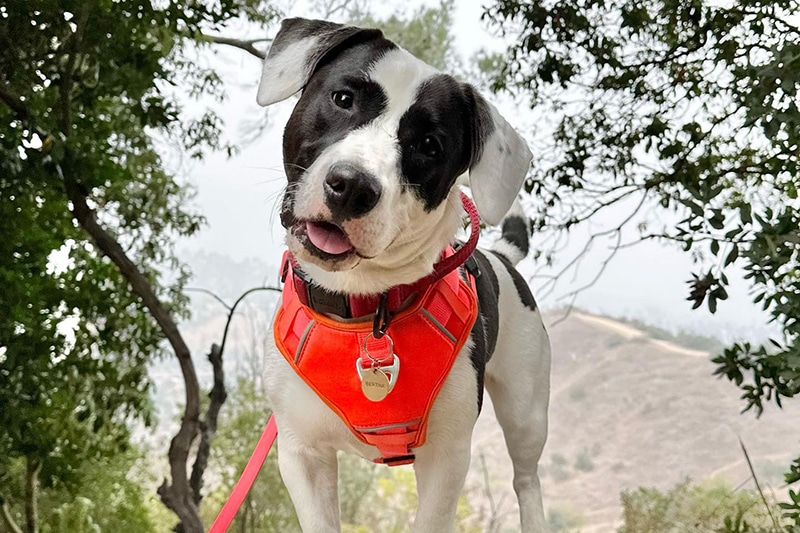The Corgi Blue Heeler mix is a medium-sized dog created by crossing the Pembroke Welsh Corgi with the Blue Heeler, otherwise known as an “Australian Cattle Dog,” creating an active, energetic breed that’s similar in size to a Border Collie.
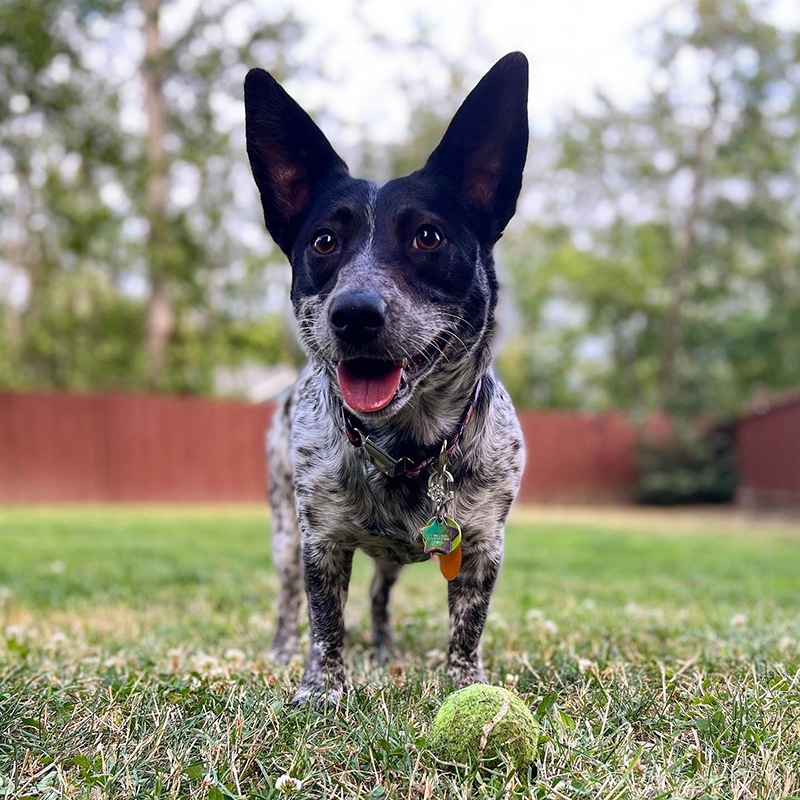
As with most designer breeds, their physical appearance, temperament, habits, and such are all reasonably unpredictable. However, we can make reasonable predictions based on their parent breeds – using what we know about the Pembroke Welsh Corgi and Australian Cattle Dogs to create a complete picture of what the Blue Heeler Corgi may look like.
Let’s examine the parent breeds’ history, temperaments, and health conditions of the parent breed to understand the Blue Heeler Corgi Mix.
Corgi Blue Heeler Mix – At a Glance
| Weight: | 26 – 40 pounds |
| Height: | 13 – 20 inches |
| Lifespan: | 10 – 16 years |
| Coat Colors: | Black, white, blue, red, brown |
| Temperament: | Energetic, intelligent, worker, independent, active |
| Most Suitable For: | Active families, farmers and homesteaders, not suitable for the elderly or apartment dwellers. |
What Does a Corgi Blue Heeler Mix Look Like?
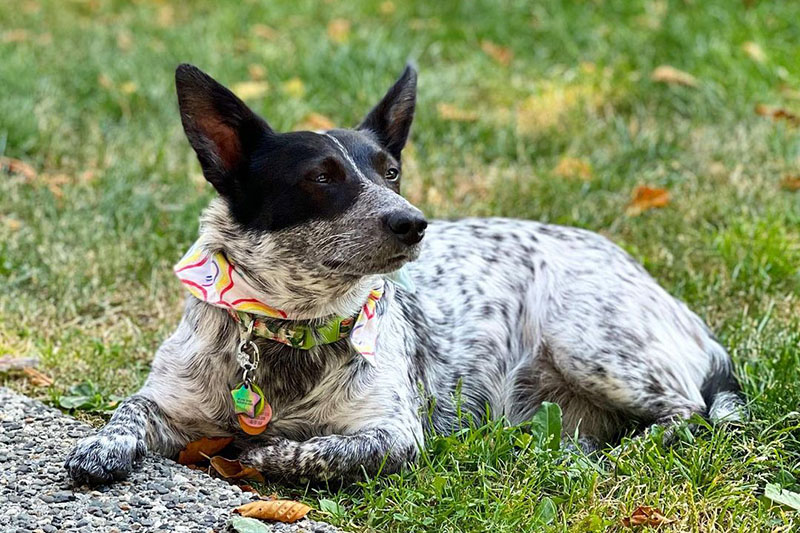
As with most designer dog breeds, their exact physical appearance can be difficult to predict – although mixed breeds tend to adopt both parts of their parent breeds’ physical appearance to varying degrees.
Your Blue Heeler Corgi will likely adopt the body size and shape of the Corgi – rounded body and short legs – with a Corgi tail and a wedge-shaped head, typical of a Blue Heeler. The most obvious Blue Heeler influence on your Blue Heeler Corgi mix will be in the coat colors and patterns of the dog.
You can also expect your Corgi Blue Heeler mix to adopt the upright ears of the Corgi.
Are you looking for a way to treat your furry friend? Sign up for our newsletter for a chance to win a free month of Barkbox!
The History of the Corgi Blue Heeler Mix
The Corgi Blue Heeler mix is a cross between the Pembroke Welsh Corgi and the Blue Heeler, or by its more popular name, the Australian Cattle Dog. Unfortunately, as a relatively new and obscure crossbreed, we don’t have much history on the Blue Heeler Corgi mix.
There is extensive history on the Corgi and Australian Cattle Dog, so we’ll use that to paint a picture of why, when, and how this working dog breed came to be.
The History of the Blue Heeler
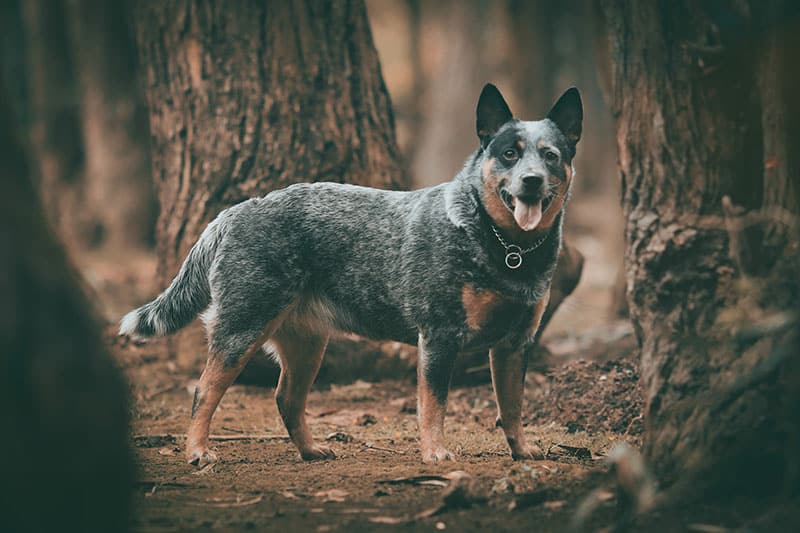
The Blue Heeler was originally an imported breed from England in 1788, finding its way to Australia with convict fleets. English cattle herding dogs were imported to Australia and then subsequently bred by English free settlers.
It wasn’t long before the Australian Cattle Dog would become roaming strays and were eventually caught and bred by a free settler, George Hall. His son, Thomas Hall, then took over the breeding of these dogs and created what would become known as the Australian Cattle Dog, or “Blue Heeler.”
The name “Blue Heeler” comes from the colors of the dog and how they herded cattle by nipping at their heels. Known for being sturdy, muscular dogs, Blue Heelers are also hearty. They have fantastic endurance levels, being bred for the hard work of outdoor herding of cattle in the inhospitable Australian outback.
Today, many Australian farmers still keep Blue Heelers as working dogs. Americans have also caught on to the Australian Cattle Dogs’ utility, bringing the first Australian Cattle Dog to America in the 1940s.
How Popular Are Blue Heelers in the United States?
Blue Heelers first came to America in the 1940s, and being herding dogs were almost immediately adopted by American farmers to aid them in cattle herding. Daily exercise was the norm and made them a surprisingly popular breed – a new addition to the American working dog landscape.
This popularity has grown steadily since the 1940s, and in 2021, Australian Cattle Dogs were the 51st most popular dog in America, according to the American Kennel Club.
Who Are Blue Heelers a Good Dog For?
Blue Heelers’ were bred to work on farms, homesteads, and ranches throughout Australia and carried on that role when they arrived in the United States. Blue Heelers make lovely working dogs.
If you own a farm, ranch, or homestead, then a Blue Heeler will be right at home! If you don’t own one of these working-dog heavens, feel free to get a Blue Heeler!
The Blue Heeler will still fit right in at your home if you are an active family that can meet their enormous exercise requirements. Blue Heelers do make great family pets, as they have great protective instincts. However, if you have children, consider that Blue Heelers also have herding instincts and may try to ‘herd’ your children – be careful and ensure they receive proper training if you notice this happening.
How Did Blue Heelers Come About?
Blue Heelers were bred from various British and Australian herding dogs – the former having been imported to Australia during the creation of prison colonies in the late 18th century. They were later distinguished as their breed by the early 19th century.
When Did We First Crossbreed the Blue Heeler?
One of the original crossbreeds of the Blue Heeler was another Australian native “dog” known as a Dingo. The Dingo is native to Australia and is technically a wolf. There were several attempts by the earliest settlers to crossbreed Dingoes and Blue Heelers, perhaps only for recreation – as there doesn’t appear to be an apparent reason to do so.
However, in more modern times, the Blue Heeler has been crossed with a variety of small to medium-sized dogs, such as the Pitbull, the Boston Terrier, the Husky, the Labrador, and the Poodle. There is also some evidence that Blue Heelers were crossbred with the Golden Retriever.
Due to their endurance and working dog nature, they’re among the more popular crosses under the ‘working dog’ category with many desirable characteristics.
The History of the Corgi
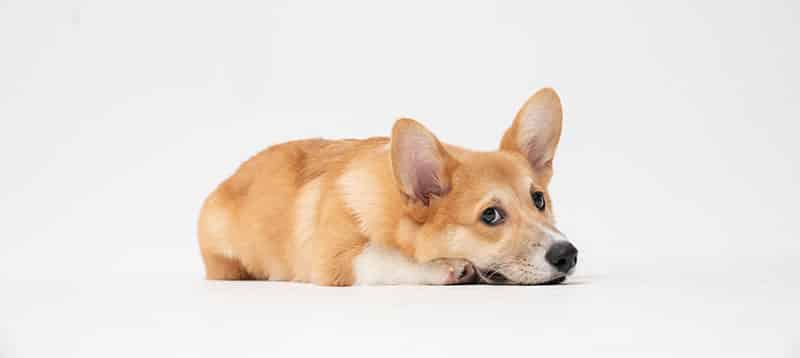
The humble Corgi is one of the world’s most popular dog breeds. From royalty to everyday people, the Pembroke Welsh and Cardigan Welsh Corgis enjoy terrific popularity among families, known for their loyalty, pleasant nature, and laissez-faire approach to life.
They were not always so popular as family pets, though. The Corgi began its life as a working dog – brought to Wales by Flemish weavers in 1107 AD; Corgis were commonly used as herding dogs on farms.
They remained working dogs for several centuries before becoming the staple companion pet they are today. The Corgi was separated into two distinct breeds in 1934 – the Pembroke Welsh and the Welsh Cardigan – each having specific physical characteristics.
Corgis were first transported to the United States in the early 1930s, with the Pembroke Welsh Corgi Club being founded in 1936, with the recognition of the breed by the American Kennel Club.
How Popular Are Corgis in the United States?
Today, Corgis are quite popular in the United States, with the Pembroke Welsh being significantly more popular than its Welsh Cardigan counterpart.
According to the American Kennel Club’s 2021 rankings, the Pembroke Welsh Corgi was the 11th most popular dog in America. Meanwhile, the Welsh Cardigan ranked 67th most popular.
Who Are Corgis a Good Dog For?
Known for their single coats, friendly demeanor, and low-maintenance nature, the Corgi is an excellent option for any family looking to add a little spice of life. Despite no longer being used as working dogs, Corgis still require a healthy amount of exercise – but aren’t known to be pullers on leashes or run off – they are usually very loyal to their owners.
Corgis are small enough to be suitable for apartment living. However, they sometimes suffer separation anxiety and can be a bit more vocal than you might imagine if left alone for long periods.
Due to their loyalty, Corgis make wonderful lifelong companion dogs and are often chosen by elderly pet owners as a medium size companions.
How Did Corgis Come About?
Flemish weavers transported the Corgi to Wales from modern-day Belgium in 1107 AD. The Corgi was initially used as a cattle-herding dog and has maintained some of its herding instincts.
Corgis would later become loyal companion pets of the Royal Family and the British public before being transported to the United States in the 1930s and becoming firm American family dogs.
When Did We First Crossbreed the Corgi?
While there is little available information concerning the first time Corgis were crossbred, Corgis are a popular crossbreeding choice among breeders – primarily due to their personality.
Their friendly, happy-go-lucky nature and moderate energy levels are easy to handle for most people, making them a favorite family dog. While the initial Corgi mix will likely have been with other English working dogs, Corgis have since been crossed with various small and medium-sized dogs.
Some of the most popular crosses include the Corgi Golden Retriever mix, the Corgi Cocker Spaniel mix, the Corgi Shiba Inu mix, the Corgi Bull Mastiff mix, and the Corgi Bernese Mountain mix. And, of course, our beloved subject of today’s article: the Blue Heeler and Corgi mix.
How Important is a Dog’s Temperament to Your Family?
Before you begin your search for a new dog to add to your family, you should ask yourself what you’re looking for in a dog.
Are you looking for a companion for your outdoor adventures? Or are you looking for something to keep your kids’ company at home? Are you considering a service dog?
There are so many different reasons to get a dog, but you’ll want to ensure that if you get a dog, you can keep it. One of the main reasons why dogs are returned to their previous, or worse, wind up in shelters is that they are temperamentally unsuitable for their new owners.
A dog’s temperament is usually decided by a mixture of things, from their genetics to their upbringing and lifestyle, to their history and current living situation. Like a Siberian Husky, an active breed is unlikely to be happy and do well in a small apartment with an inactive owner.
A Pug is far more apt to be apartment-dwelling with an inactive – as they’re not bred for hyperactivity/high-energy lifestyles, like the Husky.
Before getting a dog, please ensure you understand the temperamental possibilities and are prepared for that. Mixed-breed dogs are even more likely to have temperamental differences, as they can adopt many parts of the temperamental tendencies of their parent breeds.
What is the Temperament of the Corgi Blue Heeler Mix?
Like both parent breeds, the Heeler and Corgi mix will likely adopt different parts of each parent’s temperament. It will be a highly energetic dog, best suited for the active family. If it inherits the Corgi personality, you can expect it to be gentle and loving at home.
However, if you have children, there’s a high likelihood that the Corgi Blue Heeler will try to ‘herd’ them, as both are breeds with herding histories and high herding instincts. If you are adopting a Blue Heeler Corgi mix and have children, please keep this in mind.
Otherwise, you can expect your Heeler and Corgi mix to follow you wherever you may go dutifully! Including on trips to the bathroom! This will require training them to understand that going to the toilet is not a team sport.
Is The Corgi Blue Heeler Mix Friendly?
While the Heeler Corgi is a friendly dog, its levels of energy may become slightly too much for some people to handle. Please make sure that you train your Heeler Corgi Mix about when it’s time to stop greeting people.
Is the Corgi Blue Heeler Mix Easy to Train?
Despite their relatively high-energy nature, your Corgi Blue Heeler mix can be very good at following commands and relatively easy to train.
If your Corgi Blue Heeler mix has inherited its stubborn Corgi genes, it may require some positive reinforcement training.
How Much Can A Corgi Blue Heeler Mix Weigh?
The average weight of a Corgi Blue Heeler mix is between 26 and 40 pounds.
How Tall Can A Corgi Blue Heeler Mix Get?
You can expect your Corgi Blue Heeler mix to stand between 16 and 20 inches tall.
Similar Sized Breeds
There are a few similar-sized breeds to the Corgi Blue Heeler mix. These include medium-sized dogs such as the Labrador Retriever, the Brittany, the Boxer and the Border Collie.
Does the Corgi Blue Heeler Mix Shed?
Despite being a short-haired dog, the Corgi Blue Heeler mix is a shedding breed. As such, they require moderate brushing once per week.
How Much Exercise Does the Corgi Blue Heeler Mix Require?
The Corgi Blue Heeler mix is an exercise-intensive dog – expect to be walking your Corgi Heeler Mix for at least 30 minutes daily, as their short legs tend to tire after about half an hour of walking.
They also benefit extensively from games like fetch.
How Long Can a Corgi Blue Heeler Mix Live?
The average lifespan of a Corgi Blue Heeler mix is between 10 and 16 years.
What Health Conditions Could the Corgi Blue Heeler Mix Have?
- Hip dysplasia (hip joint inflammation)
- Elbow dysplasia (elbow joint inflammation)
- Retinal Detachment (eye condition)
- Degenerative Myelopathy (spinal cord degeneration)
How Can You Find a Corgi Blue Heeler Mix Puppy For Sale?
Before searching for a Corgi Blue Heeler mix puppy for sale, consider adopting a Corgi Heeler mix instead. Sometimes, Corgi Heeler mixes wind up in shelters and vet clinics due to accidental mating or other circumstances are just waiting for the right person to scoop them up!
Finding a Corgi Heeler online is also another adoption option. You can search AdoptAPet.com for local breeders in your area.
How Much Does a Corgi Blue Heeler Mix Puppy Cost?
Another reason to consider adoption is the cost of buying a Corgi Blue Heeler from a breeder. A Cowboy Corgi will cost you between $1200 and $1500. Meanwhile, you can adopt a Cowboy Corgi for as little as $300.
You can read our article on reputable breeders to learn more about the difference between reputable breeders and puppy mills.
Is the Corgi Blue Heeler Mix The Right Breed For You?
The Blue Heeler Corgi mix is likely to be right at home in a cozy, warm, loving home with plenty of land to allow it to run. Its energetic, affectionate, and bubbly personality is sure to be right at home with any active family unit.
The Corgi Blue Heeler mix is also good with children, despite their herding tendencies. Corgi Blue Heeler mixes mightn’t be for everyone – particularly if you live in an apartment setting or are elderly.
If the Corgi Blue Heeler mix isn’t for you – perhaps another mixed breed will be! You can read more about the other mixed-breed dogs in our breed guides, available here.


